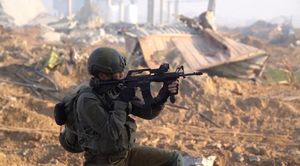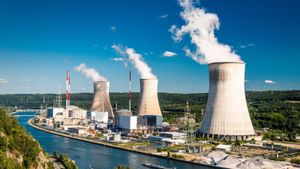Fears of nuclear war are creeping back, gripping the United States as various global tensions rise. A newly emerged map outlining potential nuclear targets across America has sparked concern, illustrating the areas most vulnerable to attack. The chilling graphic not only highlights the major cities but also indicates the remote regions potentially within the crosshairs of conflict.
Recent discussions have pinpointed significant urban centers like Washington, D.C., New York, Miami, and Philadelphia as likely targets should war break out, demonstrating the considerable risk these locations face. Military installations and other strategic sites could also find themselves under threat from nuclear strikes, especially if aggressors were to launch 500 or even 2,000 warheads toward the U.S. The map indicates how populous areas may be obliterated by such heavy bombardment.
This nuclear war map traces its origins back to 2015 when it was first published by CBS News, yet it has regained traction on social media, gathering attention globally. According to reports, the information portrayed on the map is said to draw from various authoritative sources, including the Federal Emergency Management Administration (FEMA) and the National Resources Defense Council. Nevertheless, FEMA has publicly refuted claims surrounding such detailed mapping, insisting they have no official documentation of potential nuclear targets. A spokesperson for FEMA clarified, "FEMA does not, and has not, released any type of formal map of potential nuclear targets. We provide information to help the public prepare for potential hazardous or radiological events through Ready.gov."
The United States is home to numerous strategic sites including intercontinental ballistic missile silos, military bases, and nuclear storage facilities. It's worth noting the layout of these sites appears strategic, with many located away from heavily populated areas, aiming to reduce the impact on civilian populations should the unthinkable occur. Reports suggest areas in Montana and North Dakota are deemed significant targets due to their housing of nuclear weapons and launch sites.
The alarming chart showcases nuclear weapon facilities scattered across the USA, with at least 90 operating nuclear reactors potentially adding to the list of targets. Particularly, states like Alabama, Arizona, and Maryland have been flagged as potential hotspots. The juxtaposition of expected targets reveals the high risks associated with major cities, such as Chicago and Los Angeles, not only for their size but also due to their economic significance.
With nuclear capabilities said to be growing, the discussion surrounding nuclear disarmament becomes increasingly prevalent. Recent accusations have arisen involving Russia allegedly violating agreements related to nuclear arms control, with Russia countering by asserting the U.S. itself has committed breaches. Putin's ominous remarks hinting at potential nuclear strategies beyond current geographic disputes stir worries about the future of nuclear security. His claim, "To defend Russia and our people, we doubtlessly will use all weapons resources at our disposal," raises alarm bells.
Significant attention also surrounds how fallout from such attacks may impact locations beyond immediate strike zones. Historical studies from the Institute of Medicine have investigated the immense fallout consequences from previous conflicts. They predicted, based on wind patterns and other geographical factors, widespread radioactive contamination could blanket significant parts of the country following the detonation of nuclear weapons. "If the prevailing winds are from the west, they might carry radioactive material all the way across the country, exposing millions to harmful fallout," experts indicated.
The latest map serves as both stark warning and sobering reminder of the dire state of global politics. Areas perceived as 'safe' are distributed predominantly throughout rural Idaho, Maine, and parts of Northern California. Nevertheless, even the least targeted areas should remain vigilant. Should the situation escalate, the ramifications of fallout from urban and military targets would be felt broadly, even far beyond the blast sites themselves.
Looking at the overall scenario, the threat of nuclear conflict appears to have shifted from distant fears to concrete possibilities. The potential for mass destruction looms as nations grapple with their defenses and strategies. It's clear the public must remain informed, and the discussion on nuclear safety must continue to evolve as global threats escalate. Understanding both the locations and consequences of potential nuclear strikes not only helps communities prepare but also fosters dialogue around disarmament and peace.
Indeed, as global political tensions rise, so do the fears among people everywhere, emphasizing the necessity for clear communication and comprehensive preparations to safeguard humanity against these terrifying prospects. The current conversation isn't merely about potential wartime strategies or maps marking 'hot' targets; it entails the essence of human safety, peace, and the urgent need for proactive engagement concerning nuclear threats.



